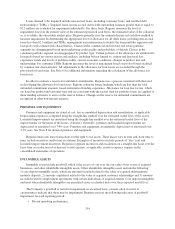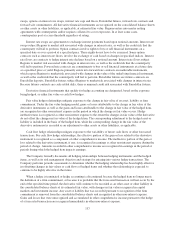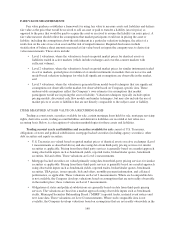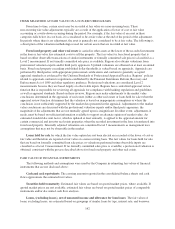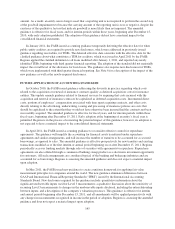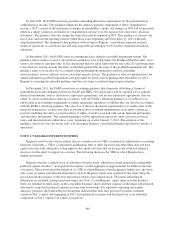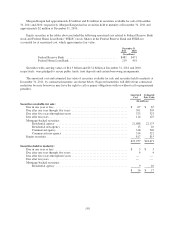Regions Bank 2011 Annual Report Download - page 165
Download and view the complete annual report
Please find page 165 of the 2011 Regions Bank annual report below. You can navigate through the pages in the report by either clicking on the pages listed below, or by using the keyword search tool below to find specific information within the annual report.market place; these valuations are Level 3 measurements. For example, auction-rate securities fall into
this category. For these instruments, internal pricing models assume converting the securities into
fixed-rate debt securities with similar credit ratings and maturity dates based on management’s
estimates of the term of the securities. Assumed terms generally fall within a range of one to four years.
• Other debt securities are valued based on Level 1, 2 and 3 measurements, depending on pricing
methodology selected and are valued primarily using data from third-party pricing services. Pricing
from these third-party pricing services is generally based on a market approach using observable inputs
such as benchmark yields, reported trades, broker/dealer quotes, issuer spreads, benchmark securities,
bids and offers, and Trade Reporting and Compliance Engine (“TRACE”) reported trades.
• Equity securities are valued based on quoted market prices of identical assets on active exchanges;
these valuations are Level 1 measurements.
A portion of Regions’ trading account assets and the majority of trading liabilities and securities available
for sale are valued using third-party pricing services. To validate pricing related to investment securities held in
the trading account assets and liabilities portfolios, pricing received from third-party pricing services is compared
to available market data for reasonableness and/or pricing information from other third-party pricing services.
Insignificant pricing adjustments may be made by traders to individual securities based upon the trader’s opinion
of value. When such adjustments are made, Regions classifies the measurement as a Level 3 measurement.
To validate pricing related to liquid investment securities, which represent the vast majority of the available
for sale portfolio (e.g., mortgage-backed securities), Regions compares price changes received from the pricing
service to overall changes in market factors in order to validate the pricing received. To validate pricing received
on less liquid investment securities in the available for sale portfolio, Regions receives pricing from third-party
brokers/dealers on a sample of securities that are then compared to the pricing received. The pricing service uses
standard observable inputs when available, for example: benchmark yields, reported trades, broker-dealer quotes,
issuer spreads, benchmark securities, and bids and offers, among others. For certain security types, additional
inputs may be used, or some inputs may not be applicable. It is not customary for Regions to adjust the pricing
received for the available for sale portfolio. In the event that prices are adjusted, Regions classifies the
measurement as a Level 3 measurement.
Mortgage loans held for sale consist of residential first mortgage loans held for sale that are valued based
on traded market prices of similar assets where available and/or discounted cash flows at market interest rates,
adjusted for securitization activities that include servicing value and market conditions, a Level 2 measurement.
Regions has elected to measure certain mortgage loans held for sale at fair value by applying the fair value option
(see additional discussion under the “Fair Value Option” section below).
Mortgage servicing rights consist of residential mortgage servicing rights and are valued using an option-
adjusted spread valuation approach, a Level 3 measurement. See Note 7 for information regarding the servicing
of financial assets and additional details regarding the assumptions relevant to this valuation.
Derivative assets and liabilities, which primarily consist of interest rate contracts that include futures,
options and swaps, are included in other assets and other liabilities (as applicable) on the consolidated balance
sheets. Interest rate swaps are predominantly traded in over-the-counter markets and, as such, values are
determined using widely accepted discounted cash flow models, which are Level 2 measurements. These
discounted cash flow models use projections of future cash payments/receipts that are discounted at mid-market
rates. The assumed cash flows are sourced from an assumed yield curve, which is consistent with industry
standards and conventions. These valuations are adjusted for the unsecured credit risk at the reporting date,
which considers collateral posted and the impact of master netting agreements. For options and futures contracts
traded in over-the-counter markets, values are determined using discounted cash flow analyses and option pricing
models based on market rates and volatilities, which are Level 2 measurements. Interest rate lock commitments
on loans intended for sale, treasury locks and credit derivatives are valued using option pricing models that
incorporate significant unobservable inputs, and therefore are Level 3 measurements.
141





